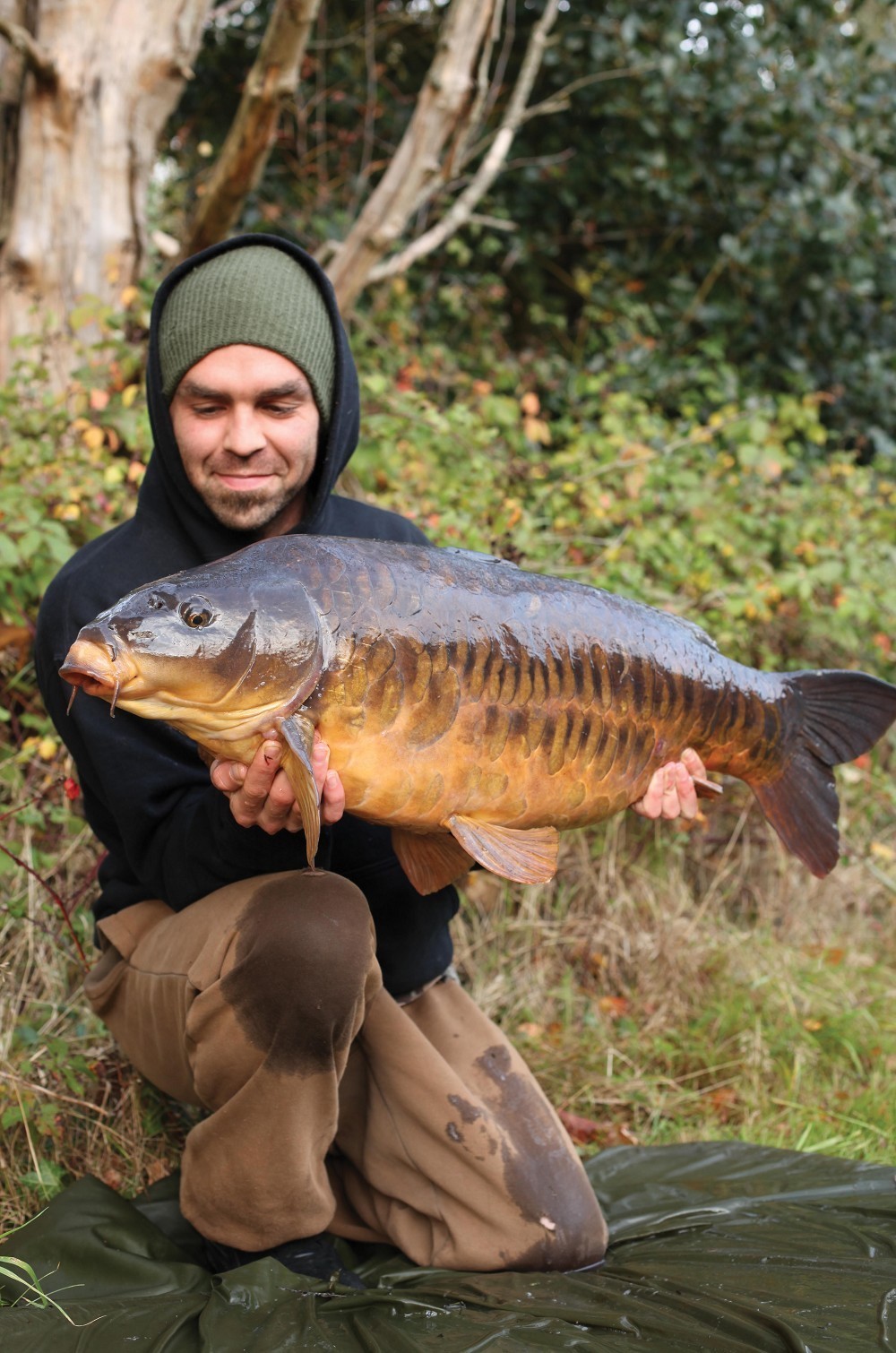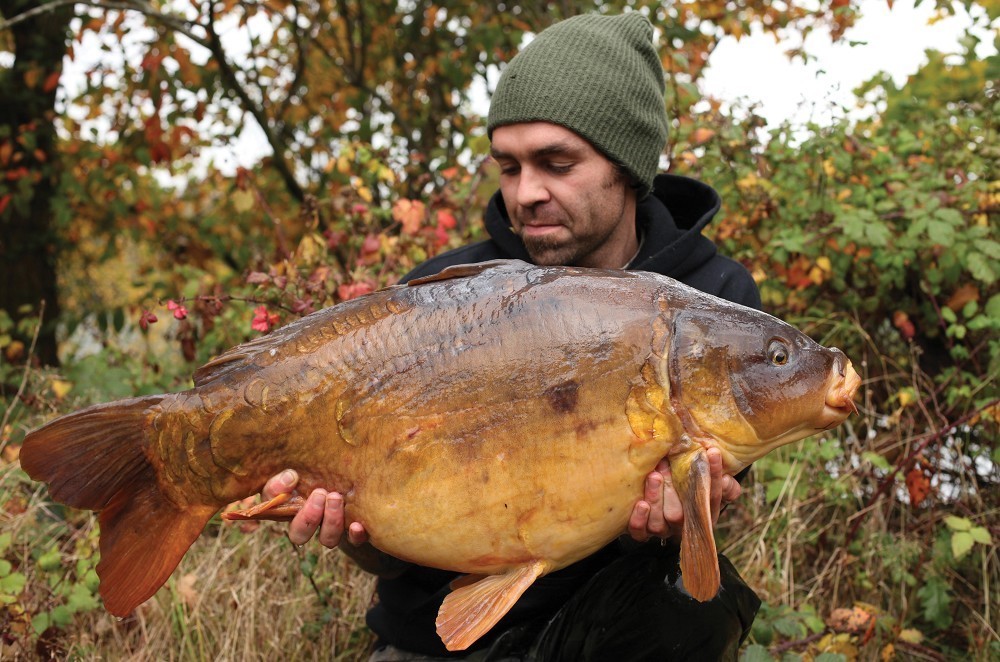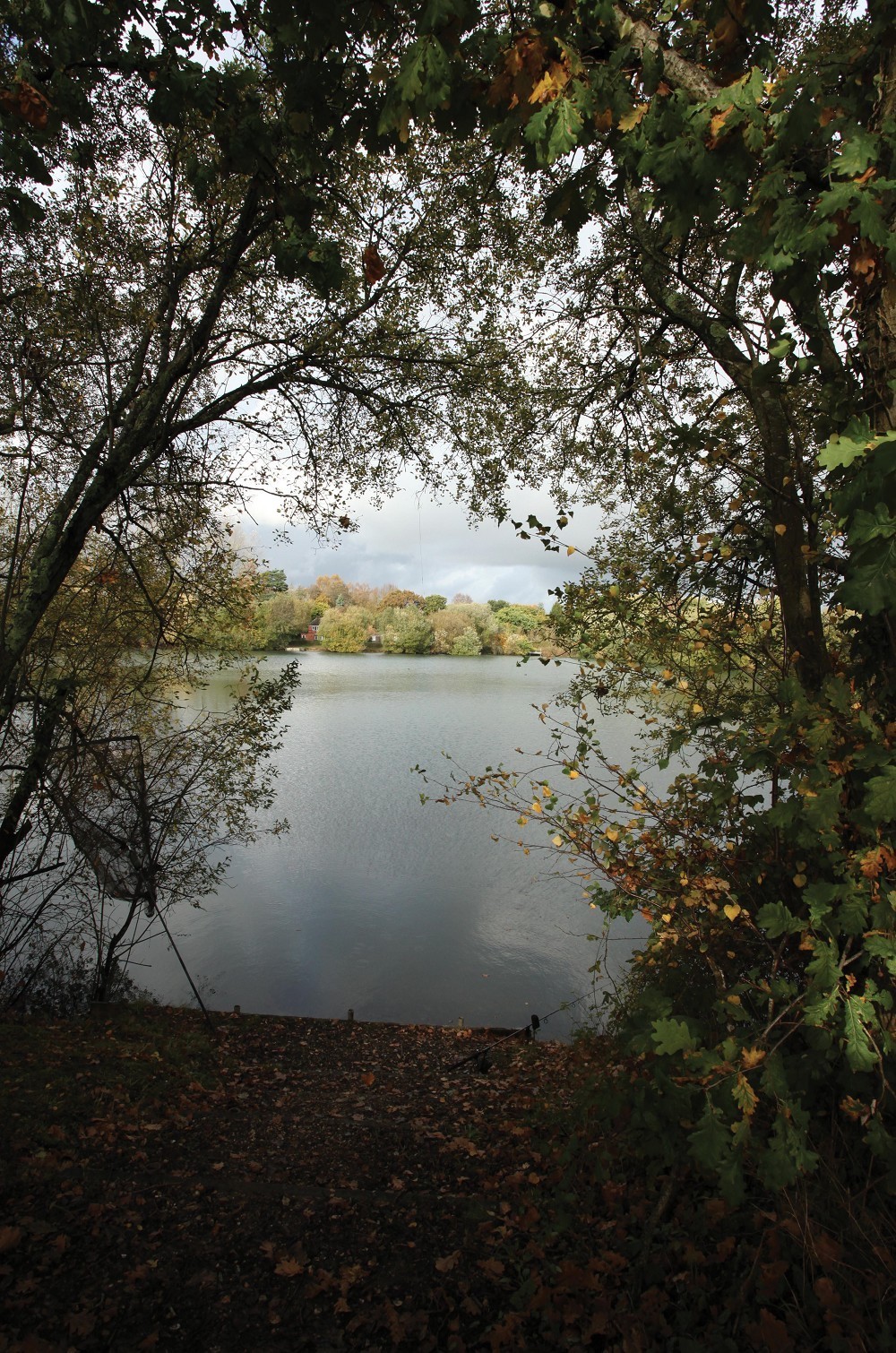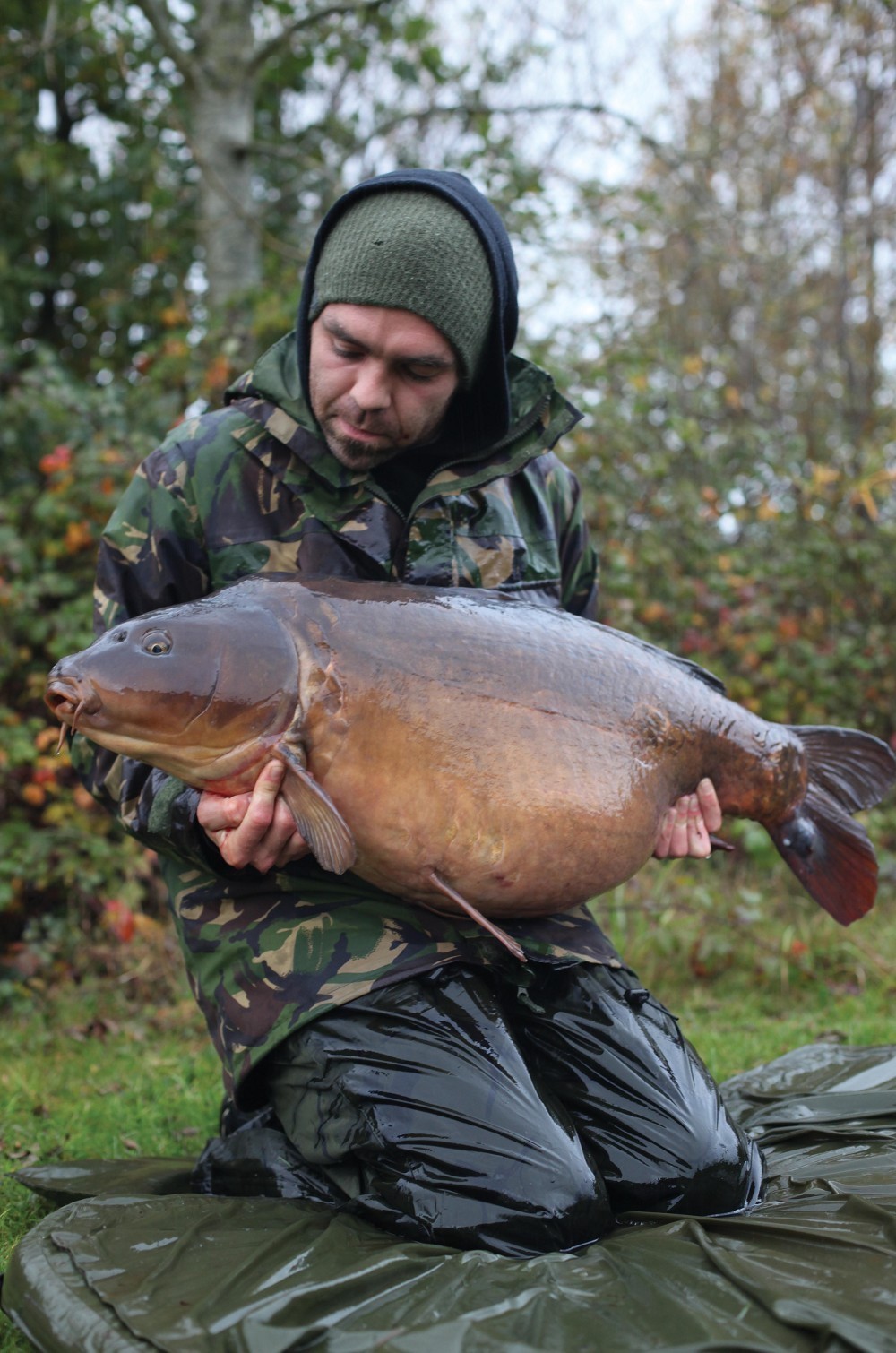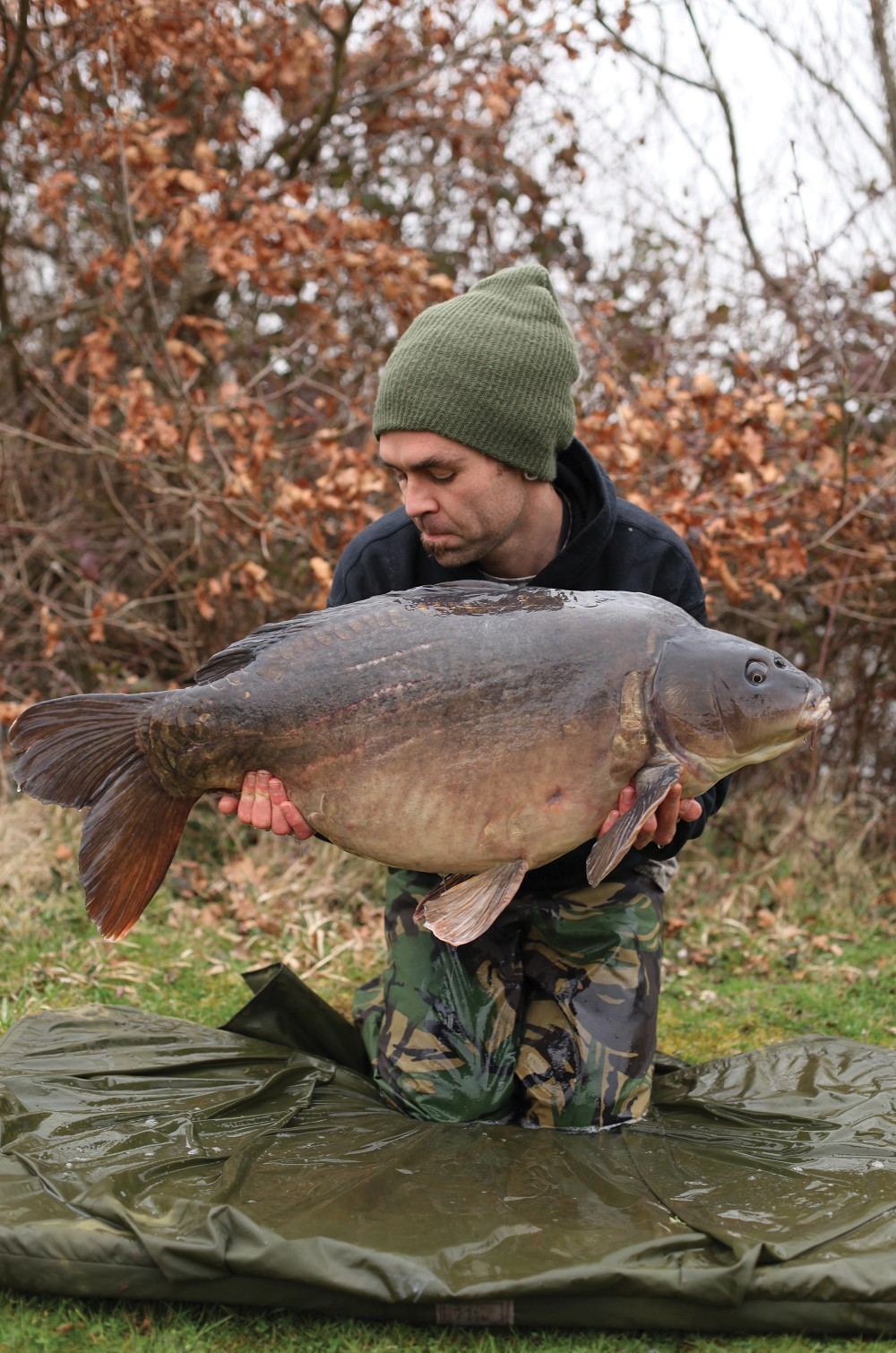Roach Pit
Gaz Fareham enjoyed some incredible overnighter success on the tricky Roach Pit
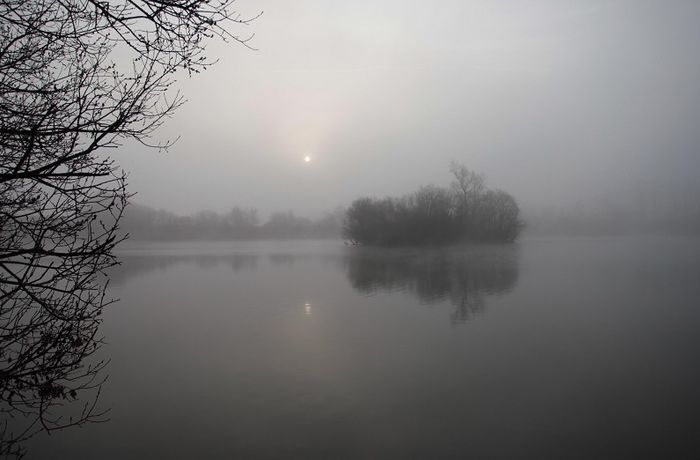
If I’m completely honest, it took me a long, long time to really find my feet again after the intensity of the angling on The Car Park. Even though I’d eventually become bored of sitting it out hoping Arfur came along, for whatever reason, I just couldn’t quite fire my enthusiasm up to the same degree for years to come, and so my first few years on The Roach Pit were relatively half-hearted at times – Hampshire Graham had been right, The Car Park had ruined me, at least for a while. In some ways though it was quite nice to not really worry too much, and to not have to feel so completely focused on trying to work towards one bite, from one particular carp and just to put the rods out in a swim, kick back and angle for what came along.
The stock of The Roach Pit was massive really compared to The CP, although at probably only maybe 40-50 fish in 24-acres it was still relatively low stock, and it was tough going too, half-a-dozen carp a season was a good average for a weekender even though occasionally it would be made to look easy to an outsider by the results of the lads with a lot more time at their disposal. In reality, the localisation of the stock and the pressure made things very difficult for long periods of time and a very frustrating prospect when you knew exactly where you needed to be but just had zero chance of getting anywhere near them.
For a while I just sort of went through the motions, trying to get the buzz stoked up, but if anything I was just enjoying the social element of the Ringwood pits and the laid back atmosphere they offered, I certainly didn’t miss the traffic-ridden drive down the M3 each week and the reduction in the diesel bill was a nice touch too. Plenty of trips were consigned to tea socials, barbeques or a Keskins buzz and pub chucks… which was no bad thing I admit, and was thoroughly enjoyed!
My problem is, I don’t really enjoy doing things by half, it is either all or nothing for me, so it didn’t take that long before I’d had enough of the half-hearted approach and figured if I ever wanted to catch any of The Roach Pit’s lovely stock, I needed a plan and to really work at it if I wanted to make something happen, it was obvious to see that if I just bumbled along with the flow I’d be lucky to catch a couple a year at most – it’s back to that convergence factor again, as an overnight angler and occasional weekender with 12-36hrs a week at your disposal you might barely get a handful of chances a year when you’re actually in the right place at the right time and everything converges. It took a while to get my head around it, but in the end I came up with a plan of sorts.
Key Point 1: Plan or no plan, that is the question...
Looking back now, it was a pretty weird first year in some ways. I fished the opening few nights in a bit of a no-hoper of a swim off a bad draw, photographed Friendly Rob’s mega hit from Pipe, ate back-to-back Keskins, a few rounds of Plug’s mother’s home-made Victoria Sponge and Lemon Drizzle, and then witnessed his epic, ever so casual midday capture of the pit’s first ever fifty-pounder. It was an amazing way to start things off, even though I had nothing to show for it myself and I left that week feeling really fired up. I caught a pretty little twenty-pound mirror the following week from Hoopers to open my season’s account and then shortly after left for a six-week van trip down the west coast of France with my new wife and the surfboards as our honeymoon, leaving the weekend school broke up and returning at the beginning of September.
As it happens I missed one of the most prolific summer’s the pit was to have during the years I fished the lake, with all the big ‘uns getting caught at big weights, some multiple times and Hoopers dominating and producing a huge percentage of the bites. Whilst on paper it looked like an amazing summer, in actual fact the carp were so incredibly localised and turned in to virtually just the one swim and just one spot that it was almost hardly worth being there if you weren’t in Hoopers, which had virtually become Ringwood prime real estate with a literal queue. Mad really, but actually quite indicative of Roach at times and they would often be very localised and frustratingly difficult to get on.
When I returned, the swim was like damaged goods: the bottom soured, and with a clear spot the size of a tennis court out there. I flitted about for September, angling off the back of what I saw and fishing around, it came to nothing and by mid-October it was looking like things were fizzling out for the year, everyone scratching around hoping for a last ditch big ‘un to close the season with from one of the big open water swims.
I felt a million miles away from a bite really and after a chat with my mate Andy one day about a late capture of his of one of the big mirrors the previous year from a quiet, under-fished little margin spot I decided I needed a plan, and so embarked on four weeks of baiting, on the quiet. I put a big hit of seed, boilie and pellet in as regularly as I could, roughly every two to three nights, booting up the spur road after work in the dark to get it in. Eventually it came good, and one November morning they turned up in numbers there and I got my last ditch chance.
Key Point 2: On my own terms
For me personally, one of the biggest considerations I have these days now I have far less time to string together is not so much how hard a lake potentially is, but how I can make it work on my own terms. There are just some pits that no matter how hard I look at the equation, I just can’t seem to balance it up in my head (or in practice). Lakes with 5 and 7 day ruling can often be difficult to work around with seemingly more anglers than ever having lots of time, the best areas are often stitched up for substantial amounts of the year.
Of course, in theory, there will always be carp to be caught from other areas, but my own personal experience over the last 25 years is that more often than not, there’s really only a limited amount of areas you want to be in at any one time if you actually want a realistic chance at catching. Those big fish circuit waters that allow 5 or 7 nights in a swim mean that for someone like myself, I could just never get myself into the areas I might want to be on anything like a regular basis – I’d rather lower my expectations and fish quieter waters for smaller ones, or harder waters that are far less prolific and attract far less anglers than just be there to make up the numbers and ‘slot in’ – that is something I just cannot stomach.
Roach Pit could be incredibly frustrating at times insomuch as the carp could be very localised, but it did have a free flow of anglers and a limited amount of time you could spend in a swim, so I always felt like if I worked hard enough, I could angle myself a chance.
The other bonus with Roach was that although at times the carp were shoal fish, and often the bulk of the stock would be grouped up in just one or two areas, there would always be a few here and there in the edges that you could fish for as well.
To me, there were two approaches on Roach that worked: one was to try and get in, and fish the main swims with big hits of bait, and play the numbers game, and the other was to ignore all that completely and prep some of the under-fished edges and corners and try and winkle out the odd one like that. For me, the big swim thing just didn’t work, even if I did manage to get in them with usually just 12-24hrs to play with, it just wasn’t enough to work the swim with bait, which was what I felt they needed: a big hit, then wait for that second or third night for things to kick in.
After an autumn of trying unsuccessfully to get a bite from any of the big swims like Pipe, 37, Caravan, Webleys etc., I decided to start prepping a little single rod spot, no bigger than an unhooking mat, and as things panned out, that one spot did nine bites from November to March 16th when it closed, and the entire rest of the pit, for all that bait and effort and time and rod hours did just two other bites I think, mad really when you look at it like that!
Key Point 3: The one rod trick
Having less time means you have to be more organised. It goes without saying that if you only have 12hrs to work with, and are arriving just on, or after dark, then the more streamlined your approach, and the more refined and simplistic it is the better – it would be no good turning up at 7pm in the dark on a wet, blowy November evening, knowing you have to be off at 8am and start messing around with fiddly PVA bag set-ups, spod mixes and finding and wrapping up to small spots at range. It could be done, of course, but it is fraught with difficulties and aggro and so the pure simplicity of swinging a single balanced tiger nut out off the front of a big snag you’ve been prepping, followed by a handful or two is a worknight dream: one rod, one spot, zero stress. Again, it comes back to doing things on your own terms, and for me, fishing spots like that, in that way, has sometimes seemed to be the best way I can make the equation work for me on busy pits.
Teaching is a stressful and often manic occupation, I never manage to get out on time no matter how hard I try, I’m usually still rushing around an hour after the bell has gone trying to sort something or other, either to prep resources for the following week, or to deal with camera or studio shoots and bookings or get my admin and e-mails up to date. Add the hour-and-half to two-hour drive to the lake in traffic into that equation and it’s nigh-on impossible to arrive in a blissful state of calm!
Knowing I’d prepped an ignored little corner a couple of times during the week, and knowing all I had to do was simply balance up a nut, lower it in and set the trap meant a lot of the potential stresses were taken out of the equation. It could be done just as efficiently and accurately after dark, and the whole process took no more than five minutes, start to finish. I loved the focus involved in carefully prepping and targeting just one little area, and I loved the additional buzz I’d get at work after dropping in a bucket the previous night – knowing there was probably a couple of big mirrors lurking around in the shadows having a feed.
Key Point 4: The Heat Treatment
It is something I have mentioned already a few times in this series, but I used Benny’s style of heat treatment trick on Roach too and it was ideal for the situation as I was only using small amounts of bait whilst I was actually fishing. I rarely had the time during the week to prep my bait in advance, and was using predominantly boilie and pellet as opposed to seed, so the first thing I would do when I arrived was stick a big kettle of lake water on to boil. In my little bucket I would put a couple of handfuls of boilie, usually dusted heavily in pure GLM powder and I simply poured the boiling water over it, until it was just covered, that would be sealed up and left to steep for the length of time it took me to get set up, get the rig balanced up and in position and the trap set.
About five minutes before I needed it I would add a few handfuls of pellet into the bucket to let it soften slightly and to soak up some of the hot, oily GLM-infused water. That gave me enough to give it just a few handfuls which would always go in hot, and was often all I was using as I was just fishing for a bite at a time.
Before I left, another couple of big buckets of boilie and pellet would go in, the hit size depending on how soon I could get back.
I’m sure the supercharge the heat gives the boilies, combined with the added effect of speeding up the ‘washed-out’ look and feel I’m sure helped, especially as the temperatures dropped.
Key Point 5: Effort equals reward? Or not...
For all the effort I put into the worknights on Roach over the years, they actually produced relatively little, but I suppose you can look at that two ways. They could either just be considered a huge waste of time and effort, and I’m not going to lie, they are a hell of a lot of effort to keep up on a regular basis and to keep the rest of your life in order at the same time, or you can look at them as being the blocks that underpin the eventual captures. Even though they are incredibly difficult to get to work for you, either because you are missing bite time, or because you simply just aren’t there long enough, or because you didn’t get the rods done well enough, they do keep you connected to the lake, both physically and mentally, and to its rhythms, and they are often vital for keeping the bait going in.
My mate Phil is currently involved in a little worknight campaign, and because of work/life commitments has traded the option of a full weekend every other week for two short worknights each week instead, opting to stay connected to the lake, and to keep a steady trickle of bait going in.
When I caught the November ones from the little one rod spot, I’d fished a worknight the previous night and had spotted that they had finally turned up and were having it, I pulled out the stops to get a bit more time and managed four bites, including a precious forty-pound mirror that salvaged my season. It wasn’t technically caught on a ‘worknight’, but it was the worknight that caught it for me.
I had the first bite just hours after getting a rod in position for the first time, having prepped it for weeks but without actually fishing it so as not to draw attention to the area. The little one rod spot did my three thirties and a forty and then two fifty-pounders in the two weeks after my hit to two other lads. I never managed to get back in there and before I knew it, it was winter and the spell had passed. I’d had my little result though, and was made up. It turned out that one of the other lads had been seeing them in there as well and because I’d kept all my baiting quiet and confined to after the hours of darkness, it was just one of those unavoidable things, and on a busy pit with lots of keen eyes is just the way things are, and something you just have to accept with a smile if you do start embarking on baiting campaigns.
I’ll admit at the time I was gutted, and I’m a bit ashamed of that now, but if you let things like that eat you up then you’ll never really enjoy your fishing, not for the right reasons anyway. I’d never knowingly drop into a swim I know someone else has been prepping, and I find I have to work around that continually these days on busy pits fishing with tight knit groups of anglers. Just this summer I have left spots alone a few times despite watching fish troughing bait on them, knowing full well they’d been prepped by a friend. Etiquette is everything I think, and we all have different ideas of what that means, but for me, I have to know something has been off my own back and efforts, and not someone else’s.
Key point 6: A divine social intervention
I left the spot lie fallow for the winter, then started prepping it lightly in early February I think it was, a couple of times a week, but not too heavy. I didn’t actually fish it, but it didn’t seem they were going to turn up in the corner before time ran out on March 16th and I hadn’t seen any sign of them in the snags.
The last weekend of the season James Turner was down, and so a social evening on Roach was duly arranged. I wasn’t fishing, but Meeky was in The Sanctuary swim which is just around the other side of the big set of snags that I’d been baiting. We sat up until late, devoured an amount of Keskins that probably puts you in coronary danger and then just before we were due to leave in the early hours, a good ‘un wallowed out just off the front of the snag, the ripples lapping up within seconds as the bulk of what must have been a big fish had shifted a lot of water.
The last night of the season fell on a Tuesday, so I hadn’t planned on fishing, but having heard that one show I knew they had finally arrived and with a mild forecast for the next few days guessed they’d probably stick around in the area and had more than likely visited that little spot already for a feed. I nipped back to bait on the Monday after work and made sure everything was prepped for one last worknight on the Tuesday.
I arrived straight from school, just as the light was fading and got the single rod in just after, within two hours I’d heard one wallow out off the snag and had a big liner, a rare occurrence fishing so close in and tight to the bank. At midnight I got the bite, it rucked hard and after a few seconds of stalemate, just as it turned, the hook pulled. I was gutted! All that effort to lose one on the last night of the season… I sat, head in hands, for a few minutes, debating whether to just get in my bag and get some sleep before summoning enough morale to tie a fresh rig and re-do it. At 4am, unbelievably I got another chance, and savoured every single minute of it as I knelt under the stars on a mild March night, playing a dogged battle out with just hours of the season left.
It was Big Tail, one of the pit’s most wanted, at just under 38lb and in prime winter condition, and was all I needed to float around without much of a care in the world until the pit re-opened on June 16th, by which time those little edge spots had a whole lot more bait invested in them and were ready for a summer of love! More of that next time… Thanks for reading.



